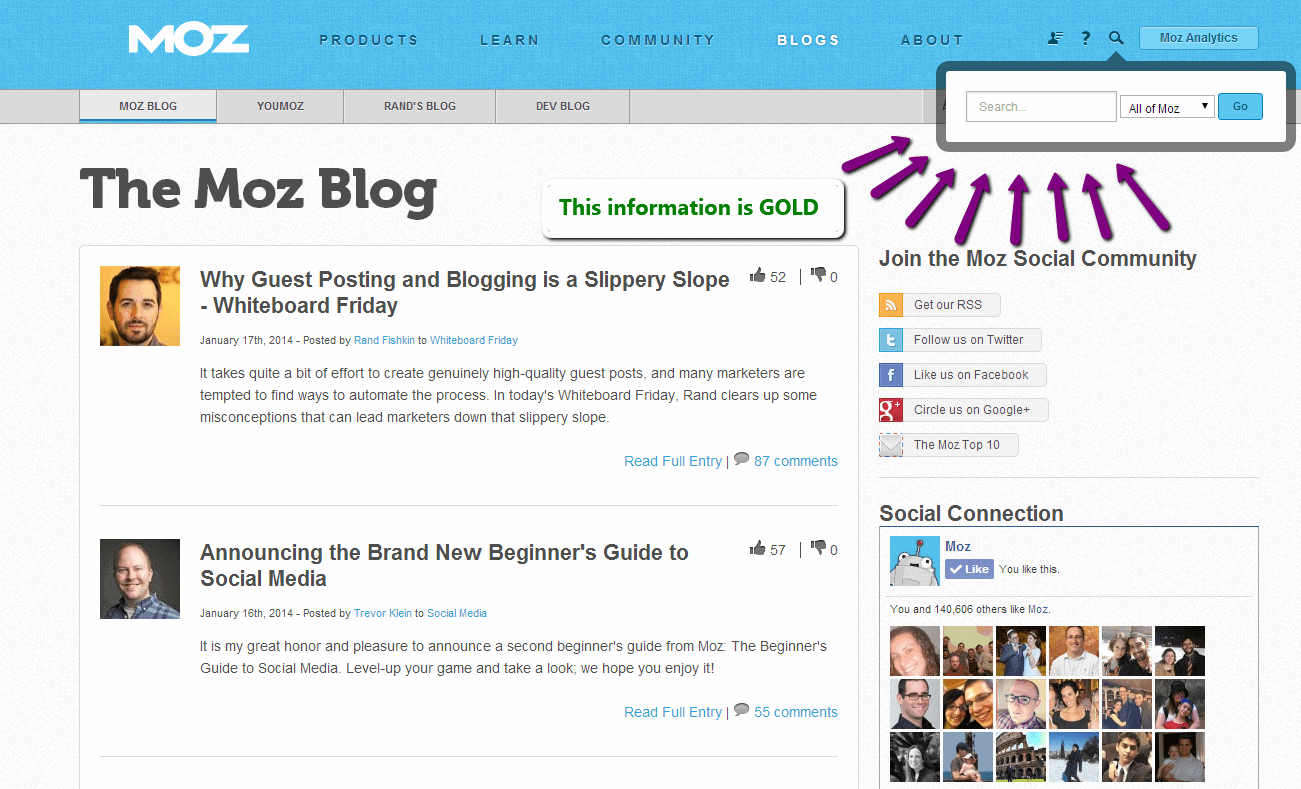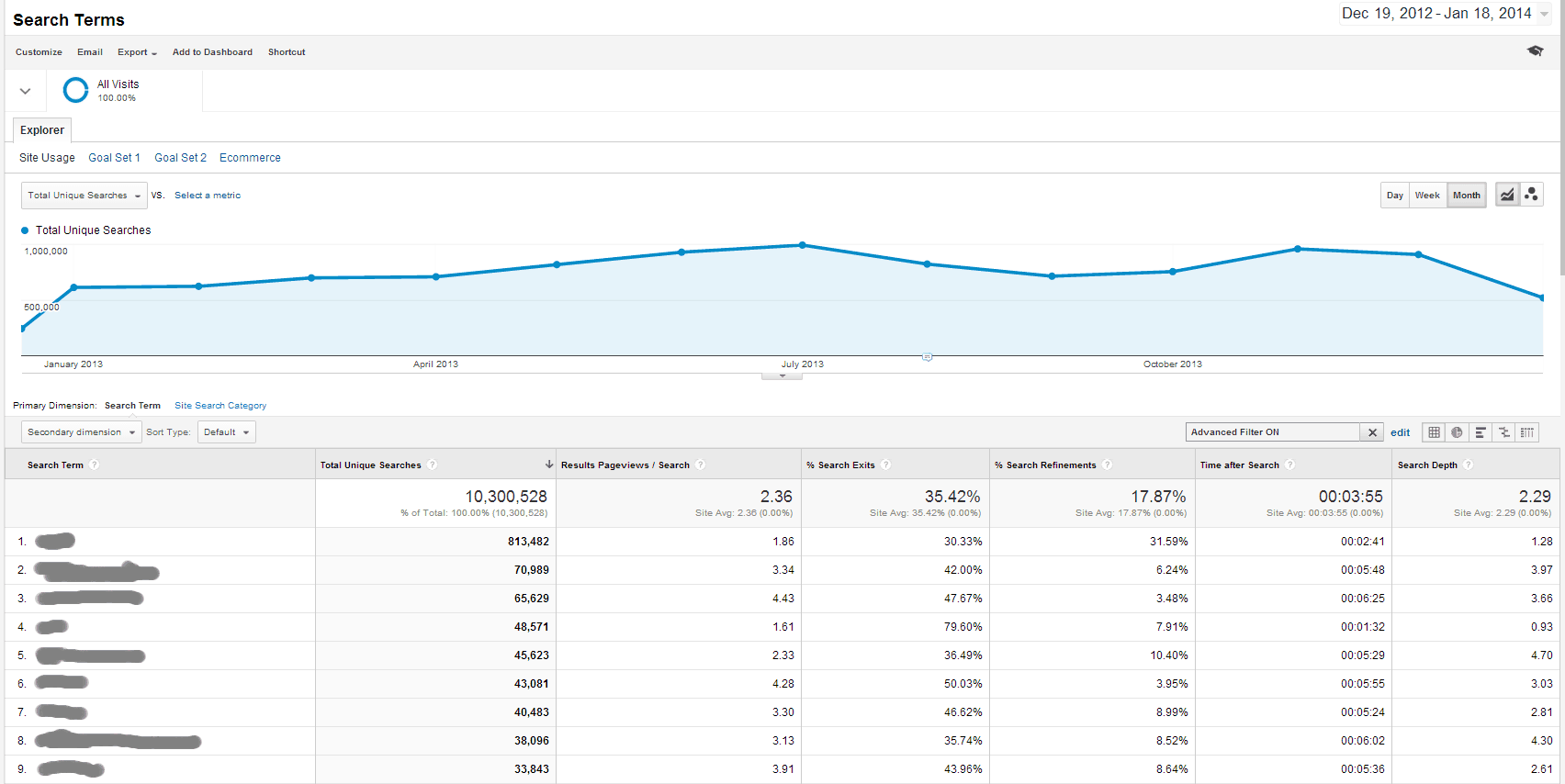You Should Care What People Search For On Your Site
Browsing on any website can be overwhelming. When you arrive on a site you know what you are looking to find. We have become accustomed to being able to locate the content we want when we want it. Whether you are looking at an e-commerce site or a general informational site, seeing the little search box in the upper corner can make you sigh in relief – finally a place to easily find what I am looking for!

“Site search” has long been ignored by webmasters and marketers alike and viewed only as assistance for site visitors to utilize custom internal search systems, such as Google, to query website data and find the exact content they are searching for.
However, this information is actually vital in developing a content strategy to increase the amount of visitors to your site and improve the overall user experience based on actual query data from real site visitors.
Bonus: If you haven’t set up Google Analytics to pull site search data, here is a quick tutorial on how to set it up: https://support.google.com/analytics/answer/1012264?hl=en
Site Search Can Help Boost Your Traffic
Marketers are constantly struggling to create quality content geared directly towards relevant users. We use search volume from Google’s Keyword Planner to get an idea of what content we think visitors would want to see and create content based on those numbers. We know content is the key to success for any website. The more content a site has, the better the likelihood it has to appear for a variety of search queries to attract a broader audience and increase the amount of traffic to your site. Content is also a share-able asset, and, as we know, more shares equals more links. More links cause an increase in site equity, and the larger the site equity, the more search queries your site will appear for. Bottom line – we need to create content!
But how does this connect to site search?
Here are a few ways we use data from site search to guide our marketing strategy.
Real Searches From Target Audience
We know what pages people find on our sites and we know what keywords have high search volume, but what about our audience? Using on-site search we are able to take the data our audience wants to see and structure our marketing and content strategy directly to our target audience.
- E-commerce sites – Determine which products should be featured on the homepage or what products we should carry more of. Search volume only teaches us about potential whereas site search data allows us to see in real time what people want to find. We can learn about our audience and work with that data to expand product lines and define which products we should emphasize.
- Lead generation sites or blogs – Learn what content requires a refresh or more importantly determine what related content needs to be added. Based on site search we can gain increased clarity on our current content and help determine how to edit marketing copy to better reach our visitors. We can find a topic for our next blog post or update a post that’s become out of date based on the information users search for on our own site.
Learn Where To Begin Targeting
Looking at Google Analytics, we can see exactly what the visitor did after looking for a term on the site. We know the ‘search depth’ of how many pages they visited after searching, as well as the amount of time they spent on the site post-search. These users are looking for pages that are either not clearly accessible or you don’t have on your site. This is exactly the kind of information we need to build a content plan using the insight from analytics as a basis for our strategy.
Create Content Based On Similar Results
Using the information provided by site search, we can expand these keywords to numerous posts which will increase traffic for actual keywords people are looking for on your site. We can then take those terms and use tools such as ubersuggest.org or Scrapebox to find a huge amount of information to build our content strategy. These tools look at actual search queries people enter into Google and scrape the data to provide us with the long tail searches from real potential site visitors.

Modifications: “Hit” added for emphasis.
DON’T HIT ENTER! (h/t Wil Reynolds) That’s the gold. Using the search terms that people looked for on your site and combining it with similar information people are looking for in Google, we can create a strong content plan relevant to your target market.
Redefine Site Structure For A Better Return
Search behavior can also help guide you in how to edit your site structure. Maybe more people are looking for women’s boots but initially that was only a subsection of women’s accessories. We should consider moving this to a whole new category if enough users are searching. These are the actual products user are looking for and this will help us determine how to best re-evaluate existing opportunities.
We can also learn what products people want but maybe aren’t purchasing and re-evaluate our products based on consumer interest. We can carry lots of ‘dresses’ but maybe people want to see more ‘party dresses’. Based on this information we can re-word our marketing copy to target the audience we are trying to reach.
While this is not inherently an “SEO issue”, this is an overall problem with site usability which can affect user behavior and play a part in the overall site experience. Fix this up and you will have a higher return on your investment and a new customer for life!
Now Go Create Content!
As we mentioned in Why Content is Still King, it’s all about creating share-able assets based on what people are searching for. We are given this information directly from our users on our own website. Now go out and create content directed at your target audience!
The possibilities are endless. How do you use site search to your benefit?
Tools To Use:

